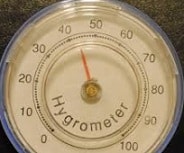In order to fully understand the meaning of the term hygrometer that concerns us now, it is necessary, first of all, to discover its etymological origin. In this case, we can state that it derives from Greek, since it is the result of the sum of two lexical components of that language:
-The adjective "hygros", which can be translated as "humid".
-The noun "metron", which is equivalent to "measurement".
Hence, starting from this etymological origin, we can determine that the hygrometer is the device that is used to measure humidity.
Likewise, we must know that the person who was in charge of coining the term in question was the German physicist, mathematician and philosopher Johann Heinrich Lambert (1728 – 1777). He coined it while he was in charge of improving the hygrometers that had been developed so far, such as those created by Leonardo da Vinci, Franco Folli and Guillaume Amontons.
Specifically, a hygrometer is a device used to measure air humidity . It is an instrument that, in the field of meteorology , is used to know what level of humidity is registered in the atmosphere.
 Typically, the hygrometer measures other quantities in a substance that absorbs moisture. When these magnitudes are known, the hygrometer can be calibrated to deduce the amount of humidity. The analysis of changes in electrical resistance and condensation temperature , meanwhile, allows electronic devices to establish differences in humidity values.
Typically, the hygrometer measures other quantities in a substance that absorbs moisture. When these magnitudes are known, the hygrometer can be calibrated to deduce the amount of humidity. The analysis of changes in electrical resistance and condensation temperature , meanwhile, allows electronic devices to establish differences in humidity values.
For meteorologists, air can hold water vapor up to a certain maximum amount, known as saturation humidity . Said capacity is established for a given temperature and pressure. The relative humidity of the air arises from the division between the humidity that the hygrometer detects in the air and the saturation humidity, expressing this result as a percentage. Relative humidity, therefore, goes from 0% (when the air is completely dry) to 100% (if the air is absolutely saturated).
From the first hygrometer designed by Leonardo da Vinci in the 15th century to today's hygrometers, multiple variants have emerged. Metal-paper coil hygrometer , hair tension hygrometer , dew point hygrometer , resistive hygrometer , capacitive hygrometer , gravimetric hygrometer and thermal hygrometer are some of them.
Among the uses of the hygrometer are humidity control in homes, warehouses, saunas and egg incubators. Knowing the humidity level is important to avoid the proliferation of fungi and other organisms.
Other information of interest about the hygrometer are the following:
-The hair tension hygrometer was created in 1783 by the Swiss scientist Horace Bénédict de Saussure (1740 – 1799).
-The first instrument of this type that was based on dew detection was created by the British physicist and chemist John Frederic Daniell (1790 – 1845) in the year 1820.
-Richard Assman (1845 – 1918), a German meteorologist, was responsible for creating the first forced air psychrometer back in the late 19th century, specifically in 1890.
